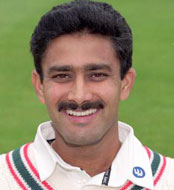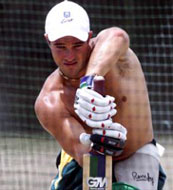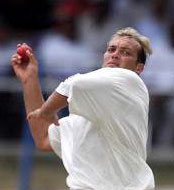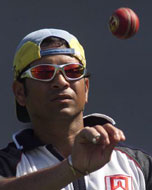Seam for success
Daniel Laidlaw
India embarks upon a tour of South Africa that is unquestionably its
toughest overseas assignment since the ill-fated tour of Australia two years ago. After disappointing results in Zimbabwe and Sri Lanka that brought into
question just how much India had improved by conquering the Aussies, a
positive result in South Africa, even if it is a competitive series
defeat,
would do much to restore India's credibility as a Test nation worthy of
respect under all conditions.
Along with a tour of Australia, a Test series in South Africa must
currently
stand as the most difficult in world cricket, especially for teams from
the
subcontinent. Fast, seaming pitches as the conditions in which to face the
home team's hostile pace attack complemented by a solid and deep batting
line-up makes playing South Africa at home a daunting challenge. The
results
prove it, as the world's second-ranked Test nation has been defeated at
home
just once in the ten years since isolation, by Mark Taylor's Australians
in
1997.
 India's success in South Africa hinges upon its seam attack.
Moderate-to-low
totals in the 250 range are an inevitability so the pacemen will need to
have an excellent series. Sri Lanka, under coach Dav Whatmore, have
recognised that spinners won't win series abroad on a consistent basis and
have implemented a long-term plan to succeed with fast bowlers. India
could
do likewise, starting with Nehra and Zaheer, as it is unlikely that Kumble
and Harbhajan will be a tandem strike force.
India's success in South Africa hinges upon its seam attack.
Moderate-to-low
totals in the 250 range are an inevitability so the pacemen will need to
have an excellent series. Sri Lanka, under coach Dav Whatmore, have
recognised that spinners won't win series abroad on a consistent basis and
have implemented a long-term plan to succeed with fast bowlers. India
could
do likewise, starting with Nehra and Zaheer, as it is unlikely that Kumble
and Harbhajan will be a tandem strike force.
Though virtually impossible to contain once in the dominant position,
periods of absolute control over an attack by the batsmen are likely to be
few and far between in South Africa. Batting should be a disciplined fight
for runs, as Pollock and co like to strangle batsmen out by restricting
the
scoring. Finding the balance between taking the initiative and utilising
natural flair against defensive-minded bowlers, and sustaining
partnerships
by preserving wickets on seamer-friendly pitches, is an awesome task.
Following is an examination of the strengths and weaknesses of each side
leading into next month's Test series.
South Africa
Strengths: If there's one word you associate with South Africa, it's discipline.
Exceedingly well-drilled in all departments, South Africa will religiously
stick to their plans and stay patient. Unlike the Aussies, they are not
committed to forcing the play, and whether batting or bowling the South
Africans are prepared to wear down the opposition in a battle of
attrition.
 A clear strength is their depth in both batting and bowling. Mark Boucher,
with 3 hundreds, comes in at No. 8. The batting talents of Pollock and
Klusener provide a tail with plenty of wag, making South Africa capable of
productive partnerships until the last wicket has fallen. The bowling is
similar. In addition to having an array of seamers to pick from, Kallis is
a respectable bowler in his own right and automatically adds depth to the
bowling attack, if not great variety. A combination of Ntini, Ngam and Nel
in support Pollock and Donald will ensure no respite for the batsmen.
A clear strength is their depth in both batting and bowling. Mark Boucher,
with 3 hundreds, comes in at No. 8. The batting talents of Pollock and
Klusener provide a tail with plenty of wag, making South Africa capable of
productive partnerships until the last wicket has fallen. The bowling is
similar. In addition to having an array of seamers to pick from, Kallis is
a respectable bowler in his own right and automatically adds depth to the
bowling attack, if not great variety. A combination of Ntini, Ngam and Nel
in support Pollock and Donald will ensure no respite for the batsmen.
South Africa remains the world's best fielding unit and hold a clear edge
over India in that area.
Weaknesses: South Africa's weakness is that they lack true flair and innovation and
will choose the conservative option over the risky one. When placed under
pressure, the batsmen are not always prepared to seize the initiative,
most notably against spinners. South Africa are also willing to accept draws
rather than take aggressive steps to pursue victory.
Their bowlers are entirely unused to being smashed around and become
disconcerted when that happens, but exploiting it is obviously immensely
difficult.
Ominously, it is difficult to identify individual weaknesses. Boeta
Dippenaar and Neil McKenzie are relatively inexperienced but the rest of
South Africa's batsmen are battle hardened. No single bowlers is yet to
clearly emerge behind Donald and Pollock, but Ntini, Nel and Ngam still
present legitimate threats even if their Test inexperience is a question
mark.
What South Africa do lack is a quality spin bowler. Paul Adams and Nicky
Boje have presently dropped off the screen and the spinner selected in
Zimbabwe was Claude Henderson, who one would not expect to trouble India.
Any spinner South Africa selects will be for token variety and whoever
does
play should provide India one of its main scoring avenues.
 Key player: Jacques Kallis. It may seem obvious, but Kallis has emerged as one of
South
Africa's most valuable players and will have a significant influence on
the
series. As their No. 3, Kallis is the lynchpin of the South African
batting
order and will be the rock around which large, methodical totals will be
built, at least if the South Africans have their way. Finding a way to
dislodge this consistent batting technician will be one of the keys to the
series.
Key player: Jacques Kallis. It may seem obvious, but Kallis has emerged as one of
South
Africa's most valuable players and will have a significant influence on
the
series. As their No. 3, Kallis is the lynchpin of the South African
batting
order and will be the rock around which large, methodical totals will be
built, at least if the South Africans have their way. Finding a way to
dislodge this consistent batting technician will be one of the keys to the
series.
If he's injury free, Kallis is also a very useful contributor with the
ball,
claiming 20 wickets in against West Indies this year with a career bowling
average of 27.54. His economical style, often bowling wide of off to help
build up pressure for his partners, makes him a quintessential member of
South Africa's attack. Perhaps Tendulkar will be the man to ensure this
tactic doesn't work.
India
Strengths: The ability to unsettle the bowlers by scoring quickly is the greatest
strength of India's strongest department, its middle order batting, but
it's hard to imagine much free scoring in this series. The potential to compile
huge partnerships and bat for long periods is another asset, with
Tendulkar, Dravid and Laxman all capable of producing a great innings on their day,
but the ability to consistently build mid-range partnerships rather than the
occasional record-setting ones will be imperative if India are to win.
Spinners should be a strength, for it's certainly a distinct advantage
over South Africa, but it's questionable just how much of an influence they
will have on pitches not offering turn. Kumble and Harbhajan may fill more of a
restrictive rather than attacking role, bowling in partnership with the
pacemen and helping to generate pressure rather than serve as
match-winners
themselves. More than likely South Africa will allow them to do this, so
the
spin battle should be much more a test of patience for the bowlers than a
test of temperament like it was in the Australian series, for example.
 For all that, India's chief strength is probably encapsulated in one word:
Tendulkar.
For all that, India's chief strength is probably encapsulated in one word:
Tendulkar.
Weaknesses: The most glaringly obvious one is the collective vulnerability to fast
bowling. Made to play constantly off the back on pitches with bounce and
seam movement, it's easy to envision a series of edges and disastrous
collapses against South Africa's disciplined pace battery.
Weak swishes outside off, an over-eagerness to play off the front foot, a
susceptibility to short-pitched bowling...these are the technical and
temperamental weaknesses which have destroyed India overseas. There really
is not much excuse for it these days and certainly Tendulkar and Dravid,
with their class and experience, do not share that failing. Das, though
largely untested so far, also seems to have the makings of a batsman who
can handle himself on livelier pitches. It's Ramesh, Ganguly, Laxman and the
reserves who are most susceptible to these types of conditions, so it
follows that they shape as India's batting weaknesses.
On the bowling front, it is the seam bowlers' tendency to become
over-enthusiastic on wickets offering them something that is potentially
costly. When Srinath, Zaheer and co find themselves bowling on pitches
that
assist seamers, as they invariably will, it's important that they do not
attempt to become different bowlers but rather continue to stick to their
fundamentals and get the most out of the conditions available. How often
do
we see over-eager fast bowlers bang it in too short when they're presented
with a helpful pitch?
Key player: Javagal Srinath. As India's principal seam bowler, Srinath is responsible
for making inroads into South Africa's formidable batting with the new
ball.
If he doesn't, and too much is left to the less experienced Zaheer and
Nehra, India will be spending some long days in the field. A 15-wicket
series is within reason and should definitely be possible given Srinath's
ability to move the ball both ways off the seam.
It would help if Srinath could establish a dominance over at least one
member of the top order. That player could be Gibbs if the cocksure opener
over-attacks against the moving ball.
More Columns
Mail Daniel Laidlaw